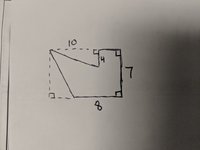The Tan Gent
New member
- Joined
- Apr 15, 2019
- Messages
- 4
I need suggestions on how to find the area of the composite figure shown. I understand the concept of how to go about this, I am just stuck on determining some of the measurements from the diagram. My approach was to calculate the area of the rectangle and subtract the two right triangle areas, but I am stuck on finding some required measurements.

